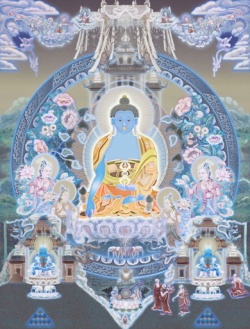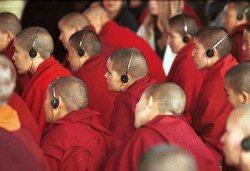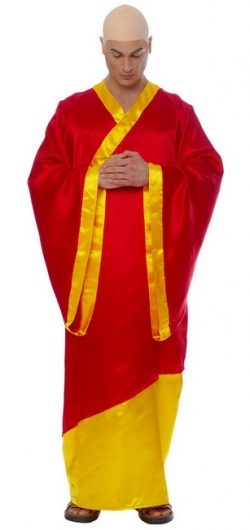Who is your root guru?
Root Guru
This is not real knowledge. If we say that we have discovered Dzogchen, it does not mean that we are accepting something. Knowledge of Dzogchen means that we have discovered our nature, and that means remembering the difference between discovering and merely "accepting" something, two completely different ideas. The principle is discovery. You discover the teacher and the qualification of the teacher. Then you discover the transmission and the qualification of the transmission. You discover there is nothing to change.
Some people say, for example, "You are a very good teacher. I want you to be my root Guru." This point of view is really mistaken, because being a root Guru means that a teacher communicates with you and that you wake up and discover your real nature through this teacher and this transmission. In this case, even if you do not accept this teacher, or you have decided that this teacher is not your root Guru, there is nothing to do. He is your root Guru. Even if he is a dog, he is your root Guru! Even if he doesn't sit on a high throne, or dress nicely, or if he is not a very famous teacher, it does not matter.
If you choose someone as your root Guru, saying, "Oh this is a very famous teacher and everybody is saying that this is an enlightened being - wonderful!" and then you say, "Oh, this is my root Guru," even though you did not experience him that way, that is totally false. Why is he your root Guru? Perhaps you never received a single teaching - how can he then be your root Guru? You see, in society we don't understand what it means to be a Guru. It means teaching and giving transmission. That is why, in the Dzogchen way, we need to discover everything; we don't need to decide anything at all. As to the value of the teaching, you say, "Dzogchen is a wonderful teaching," but this does not mean anything. Dzogchen is interesting or powerful or important only if through it you wake up to discover your real nature. Then you find that Dzogchen has a real function.
Accepting a root guru, is like taking refuge in Buddha. This need not be an explicit ceremony, but taken in the student heart
I studied in the zen tradition and I sense that my teacher has helped me in numerous ways without explicitly telling me what to do.
Rather then trying to walk the path on your own, it is better to follow a living person. With a personal connection the teacher will surely help the student cross the gate.
Root Guru is Buddha Sakyamuni for all schools, and Buddha Amitabha for Pureland. And the ultimate root guru is having the faith of one's real lovely nature is buddha and embarked on the journey to attain the faith of heshetheyit are a Buddha as well. The requires teachers and transmissions, they are all the same, different doors in a same hall, different rivers into a same ocean, differents planets floating in the same space.
All methods except pureland, rely on self ability to move up the ladder, a step at a time, from human (differents level) > 1st level to 28th level of heavenly beings (different levels in each stage) > enter stream to arahats (different levels in each) > 52 levels of bodhisavattas > Buddha.
Pureland relies on both buddha's vow and self vow to earn pureland's wealth for rebirth, the meditation bliss or entry requirement is much lower than self ability. Liken to taking lift to reach 100 storeys high building instead of claiming the stairs. And one will find difficulty while claiming the stairs along the way, and there is also more problem experienced by the disables. Thus, pureland is meant for all grades, although all schools are the same destination.
Root Guru for Tibetan Buddhism is more towards Guru Padmasambhava (Guru Rinpoche) and both with Pema Lingpa for Bhutan side. Not necessarily Buddha for all Schools.
For the Karmapa Tibetan Buddhism (white sect) , the 17th Karmapa is the Root Guru.
For True Buddha School cult, a human Lu Sheng Yen is the Root Guru. They have to visualise him on top of head, visualise him emitting three types of lights into their eyebrow, throat and heart.
Root Guru can varies for different schools. Not necessarily is only the Buddha.
I think what Chogyal Namkhai Norbu Rinpoche is saying, is that your true root guru is only one: the person who led you to enlightenment. This makes sense. However, here is how Choegon Rinpoche explains it:
2) Rinpoche. Can one have more than one Root Guru?
A: I would say if you have received or wish to receive oral instructions from several masters, then those masters also become your root guru.
I have Khamtrul Rinpoche as my root guru, Dilgo Khyentse Rinpoche is my root guru, and Adeu Rinpoche is my root guru. These masters have given me so many oral instructions, empowerments and meditation pointing out instructions that they all are my root gurus. So if people received oral instructions from many masters, they would also have many root gurus.
But when you become enlightened, although you may have many important gurus, you will consider only one of them as your root guru. This is because you don’t get enlightened again and again. You get enlightened only once. So, basically when you attain enlightenment you have only one root guru, the one that made you enlightened.
Until you attain enlightenment, of course you can have many root gurus. There is no problem with this. If you just depend on one, maybe your karmically connected guru is still somewhere else. But do not go to everybody and anybody. You have previously asked why there are so many lineages or sects. So once again here, before you receive oral instruction, you have to find the proper lineage for yourself, the master who has meditated, who has the lineage, who has the kindness, who can instruct you. Then you can go to him.
But don’t go just because he is a very high lama or carry a big title, or he has a very large following, or he is very successful. That doesn’t serve any useful purpose. Why is this so? Because you may not be able to receive teachings from him, or maybe he will not treat you as his heart son. Some fully enlightened masters are capable of picking up the flower from the mud, so to speak, and identify an exceptional disciple within the crowd. In that case, there is no problem. Otherwise, a lot of people suffer. They just go because the master has a big following or is very renowned. When they don’t get connected, they suffer. They complain, “I don’t get the opportunity to see the master, it is so difficult, I cannot see him.” Then, it’s too late.
Some masters like Dilgo Khyentse Rinpoche are truly very capable. He could pick out from among the monks the exceptional one and dearly give him important teachings. Later that person would become a great yogi.
In our lineage, Shakya Shri was just someone who was looking after the monastery’s horses. The 6th Khamtrul Rinpoche Tenpai Nyima (1849-1907) said, “Don’t treat him like cow dung! One day you all will need to get blessings from him. He will be like Dorje Chang.”
Khamtrul Rinpoche said this about Shakya Shri, an ordinary person who was just taking care of horses. He instructed him, and later Shakya Shri became one of the highest and greatest yogis in Tibetan history. In his early life, he was just a shepherd, looking after cows, sheep and horses. When in his twenties, he started practicing, and he became the greatest Dzogchen and Mahamudra yogi, respected by Jamyang Khyentse Wangpo, Jamgon Khongtrul and all great masters. He received direct teachings from Milarepa. That kind of master is very rare.
So, you have to find a real master. Not just by looking here and there.


